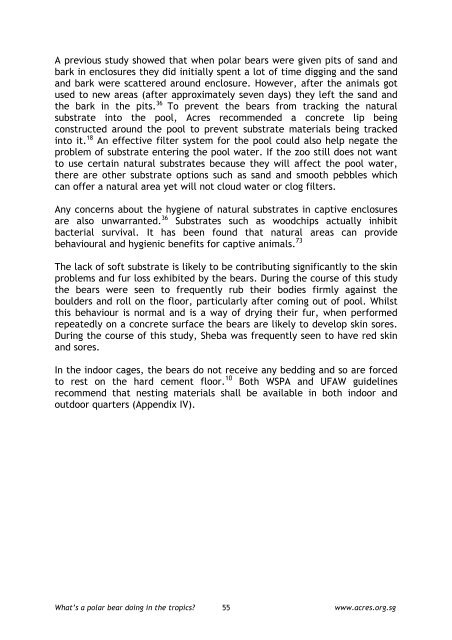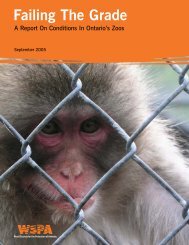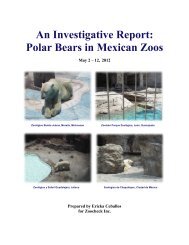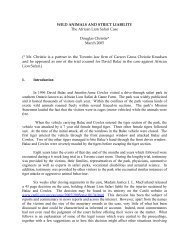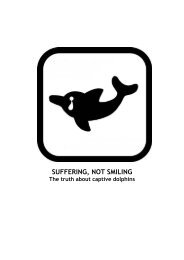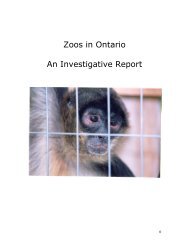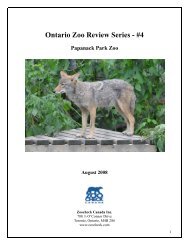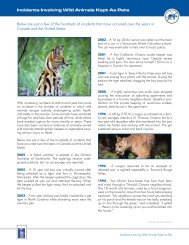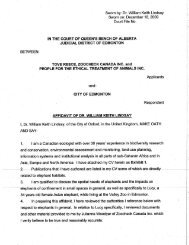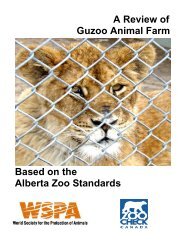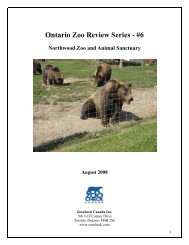What's a Polar Bear Doing in the Tropics? - Animal Concerns ...
What's a Polar Bear Doing in the Tropics? - Animal Concerns ...
What's a Polar Bear Doing in the Tropics? - Animal Concerns ...
Create successful ePaper yourself
Turn your PDF publications into a flip-book with our unique Google optimized e-Paper software.
A previous study showed that when polar bears were given pits of sand andbark <strong>in</strong> enclosures <strong>the</strong>y did <strong>in</strong>itially spent a lot of time digg<strong>in</strong>g and <strong>the</strong> sandand bark were scattered around enclosure. However, after <strong>the</strong> animals gotused to new areas (after approximately seven days) <strong>the</strong>y left <strong>the</strong> sand and<strong>the</strong> bark <strong>in</strong> <strong>the</strong> pits. 36 To prevent <strong>the</strong> bears from track<strong>in</strong>g <strong>the</strong> naturalsubstrate <strong>in</strong>to <strong>the</strong> pool, Acres recommended a concrete lip be<strong>in</strong>gconstructed around <strong>the</strong> pool to prevent substrate materials be<strong>in</strong>g tracked<strong>in</strong>to it. 18 An effective filter system for <strong>the</strong> pool could also help negate <strong>the</strong>problem of substrate enter<strong>in</strong>g <strong>the</strong> pool water. If <strong>the</strong> zoo still does not wantto use certa<strong>in</strong> natural substrates because <strong>the</strong>y will affect <strong>the</strong> pool water,<strong>the</strong>re are o<strong>the</strong>r substrate options such as sand and smooth pebbles whichcan offer a natural area yet will not cloud water or clog filters.Any concerns about <strong>the</strong> hygiene of natural substrates <strong>in</strong> captive enclosuresare also unwarranted. 36 Substrates such as woodchips actually <strong>in</strong>hibitbacterial survival. It has been found that natural areas can providebehavioural and hygienic benefits for captive animals. 73The lack of soft substrate is likely to be contribut<strong>in</strong>g significantly to <strong>the</strong> sk<strong>in</strong>problems and fur loss exhibited by <strong>the</strong> bears. Dur<strong>in</strong>g <strong>the</strong> course of this study<strong>the</strong> bears were seen to frequently rub <strong>the</strong>ir bodies firmly aga<strong>in</strong>st <strong>the</strong>boulders and roll on <strong>the</strong> floor, particularly after com<strong>in</strong>g out of pool. Whilstthis behaviour is normal and is a way of dry<strong>in</strong>g <strong>the</strong>ir fur, when performedrepeatedly on a concrete surface <strong>the</strong> bears are likely to develop sk<strong>in</strong> sores.Dur<strong>in</strong>g <strong>the</strong> course of this study, Sheba was frequently seen to have red sk<strong>in</strong>and sores.In <strong>the</strong> <strong>in</strong>door cages, <strong>the</strong> bears do not receive any bedd<strong>in</strong>g and so are forcedto rest on <strong>the</strong> hard cement floor. 10 Both WSPA and UFAW guidel<strong>in</strong>esrecommend that nest<strong>in</strong>g materials shall be available <strong>in</strong> both <strong>in</strong>door andoutdoor quarters (Appendix IV).What’s a polar bear do<strong>in</strong>g <strong>in</strong> <strong>the</strong> tropics?55www.acres.org.sg


